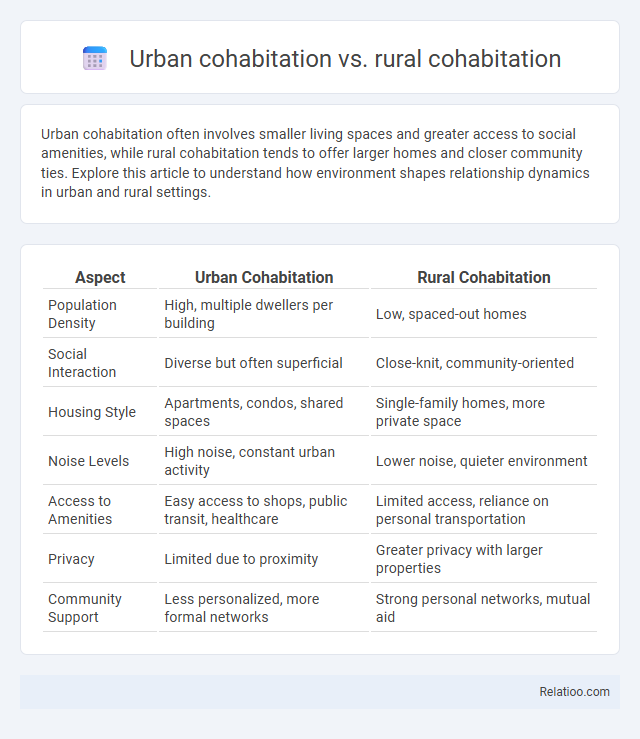Urban cohabitation often involves smaller living spaces and greater access to social amenities, while rural cohabitation tends to offer larger homes and closer community ties. Explore this article to understand how environment shapes relationship dynamics in urban and rural settings.
Table of Comparison
| Aspect | Urban Cohabitation | Rural Cohabitation |
|---|---|---|
| Population Density | High, multiple dwellers per building | Low, spaced-out homes |
| Social Interaction | Diverse but often superficial | Close-knit, community-oriented |
| Housing Style | Apartments, condos, shared spaces | Single-family homes, more private space |
| Noise Levels | High noise, constant urban activity | Lower noise, quieter environment |
| Access to Amenities | Easy access to shops, public transit, healthcare | Limited access, reliance on personal transportation |
| Privacy | Limited due to proximity | Greater privacy with larger properties |
| Community Support | Less personalized, more formal networks | Strong personal networks, mutual aid |
Defining Urban and Rural Cohabitation
Urban cohabitation typically involves couples living together in densely populated cities with access to extensive amenities, public services, and diverse social networks, while rural cohabitation occurs in less populated areas characterized by closer community ties and limited infrastructure. Cohabitation, regardless of setting, refers to two people sharing a domestic life without marriage, but urban settings often influence lifestyle choices and social dynamics differently than rural environments. Your understanding of urban and rural cohabitation can impact decisions related to housing, social interaction, and resource availability.
Demographic Trends in Urban vs Rural Cohabitation
Urban cohabitation rates have surged due to younger populations prioritizing flexible living arrangements, reflecting demographic trends such as higher education levels and delayed marriage in cities. Rural cohabitation remains lower, influenced by traditional values and older average age demographics, with family structures favoring marriage over non-marital partnerships. Understanding these contrasts helps you grasp how demographic shifts shape cohabitation patterns across different environments.
Socioeconomic Factors Impacting Cohabitation
Urban cohabitation often benefits from higher income levels, greater employment opportunities, and access to diverse social services, which can support financial independence and relationship stability. Rural cohabitation, however, may face socioeconomic challenges such as limited job prospects, lower educational attainment, and reduced healthcare access, influencing cohabitation rates and relationship dynamics. Overall, socioeconomic factors including income disparity, employment status, and educational opportunities critically shape patterns and outcomes of cohabitation in both urban and rural settings.
Housing Availability and Living Arrangements
Urban cohabitation typically features limited housing availability with higher density living arrangements such as apartments and shared spaces, driven by population concentration and real estate costs. Rural cohabitation offers more spacious and affordable housing options, including single-family homes and larger plots of land, supporting extended family living and multi-generational households. Overall, cohabitation patterns vary significantly based on geographic location, impacting access to amenities, privacy, and social dynamics within different housing environments.
Cultural Attitudes Toward Cohabitation
Cultural attitudes toward urban cohabitation often reflect greater acceptance due to diverse populations and progressive social norms, whereas rural cohabitation tends to face more traditional views and social stigma rooted in conservative values. Urban areas exhibit higher rates of cohabitation as a socially normative practice, influenced by increased educational opportunities and economic independence. In contrast, cohabitation in rural regions may be less prevalent and perceived as unconventional, shaped by stronger emphasis on marriage and family structures.
Privacy, Space, and Lifestyle Differences
Urban cohabitation often challenges privacy due to limited space and close proximity to neighbors, while rural cohabitation typically offers greater personal space and quieter surroundings that enhance privacy. Your lifestyle in urban areas may involve a fast-paced environment with convenient access to amenities, contrasted with the slower, nature-oriented lifestyle common in rural settings. Cohabitation dynamics vary significantly by location, influencing social interactions, noise levels, and available living space.
Legal and Regulatory Considerations
Urban cohabitation often involves stricter legal and regulatory considerations due to denser populations and complex zoning laws, requiring You to navigate detailed tenancy agreements and local cohabitation statutes. Rural cohabitation typically faces fewer regulations, with less oversight and more informal arrangements, but may still require compliance with state-level domestic partnership or common-law marriage laws. Cohabitation laws vary widely across jurisdictions, making it essential to understand specific legal rights, property claims, and financial obligations tied to cohabitating partners in your area.
Relationship Stability and Cohabitation Duration
Urban cohabitation often exhibits shorter cohabitation duration and lower relationship stability compared to rural cohabitation, primarily due to faster-paced lifestyles and greater social mobility in urban areas. Rural cohabitation tends to be characterized by longer durations and higher stability, influenced by stronger community ties and traditional values. Overall, cohabitation stability and duration are significantly impacted by environmental factors, with rural settings fostering more enduring relationships than urban contexts.
Access to Resources and Social Support
Urban cohabitation offers greater access to diverse resources such as healthcare, education, and employment opportunities, facilitating enhanced social support networks compared to rural settings. Rural cohabitation often emphasizes close-knit community ties, providing robust emotional support but limited access to specialized services and amenities. Understanding these dynamics helps you optimize your living situation based on proximity to resources and the nature of social support systems essential for well-being.
Future Outlook on Urban and Rural Cohabitation
Urban cohabitation is expected to rise due to increasing population density, housing costs, and urbanization trends, driving demand for shared living spaces and co-living communities. Rural cohabitation may experience slower growth, influenced by limited infrastructure, economic opportunities, and demographic shifts such as aging populations and youth migration to cities. Overall, the future outlook indicates that urban cohabitation will dominate as a practical solution for affordability and social connectivity, while rural cohabitation may evolve more gradually, shaped by localized socioeconomic factors.

Infographic: Urban cohabitation vs Rural cohabitation
 relatioo.com
relatioo.com